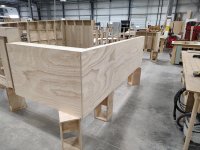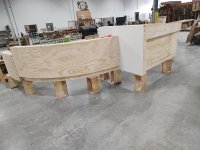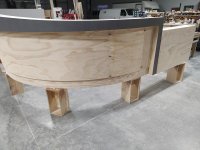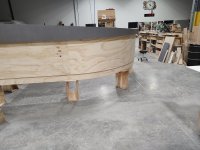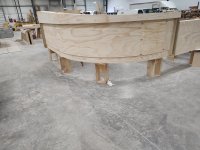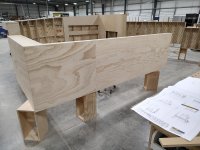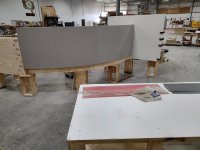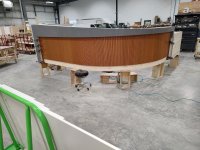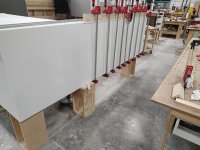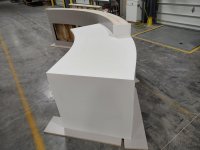Crazyraceguy
Member
- Joined
- Oct 16, 2015
- Messages
- 4,887
It not even close to the size of the largest ever, but since we moved to the current facility, largest overall. There have been a couple that were similar in length, but not as wide or tall.
It is basically dictated by several columns in the area that it will occupy. It is roughly symmetrical, but not really, there are significant differences from side to side. The is a large L section that is not in place, in the photos. It connects via that piece of french cleat, turning the center into a square U, with quarter-round wings on each side. They are not really equal either, since the finishing materials are different.
This one has been a "hot rush" starting it on Tuesday, but I was off (medical) on Wednesday, and no one touched it. So, between the 2 of us (my apprentice) we got it pretty far. We spent 5 more hours (each) on Saturday, me laminating some of the exterior and him on the solid surface. Somehow, I am missing 2 of the pics I took on Saturday? It has to ship in the early AM on Wednesday, so done Tuesday afternoon.
Much more to come, since there is a lot more Corian, with waterfall edges.
It is basically dictated by several columns in the area that it will occupy. It is roughly symmetrical, but not really, there are significant differences from side to side. The is a large L section that is not in place, in the photos. It connects via that piece of french cleat, turning the center into a square U, with quarter-round wings on each side. They are not really equal either, since the finishing materials are different.
This one has been a "hot rush" starting it on Tuesday, but I was off (medical) on Wednesday, and no one touched it. So, between the 2 of us (my apprentice) we got it pretty far. We spent 5 more hours (each) on Saturday, me laminating some of the exterior and him on the solid surface. Somehow, I am missing 2 of the pics I took on Saturday? It has to ship in the early AM on Wednesday, so done Tuesday afternoon.
Much more to come, since there is a lot more Corian, with waterfall edges.

